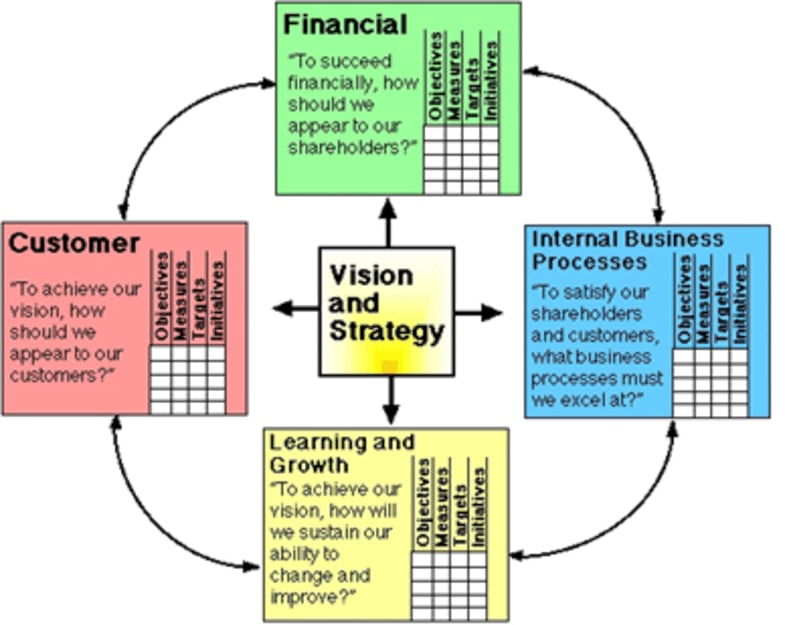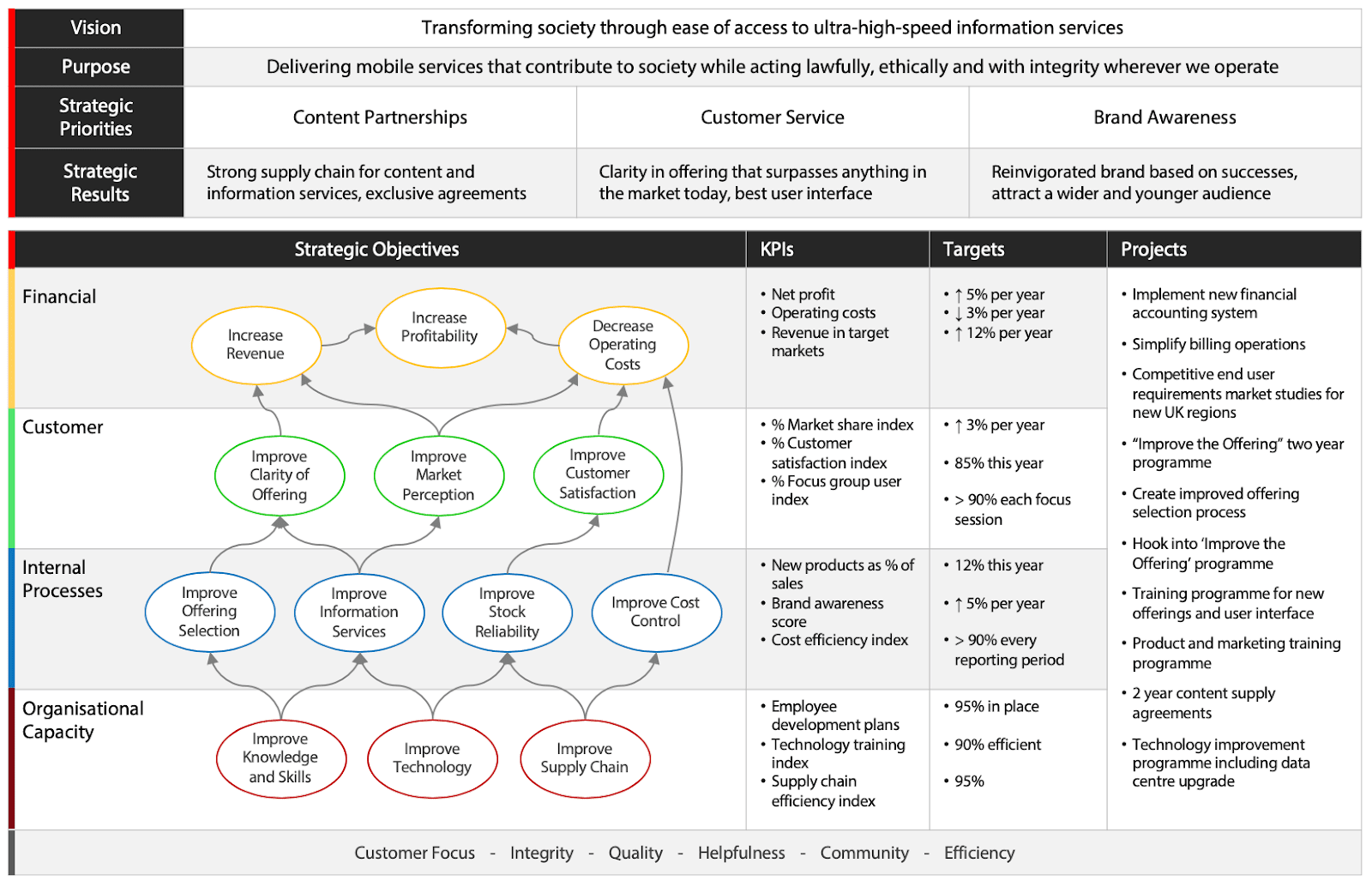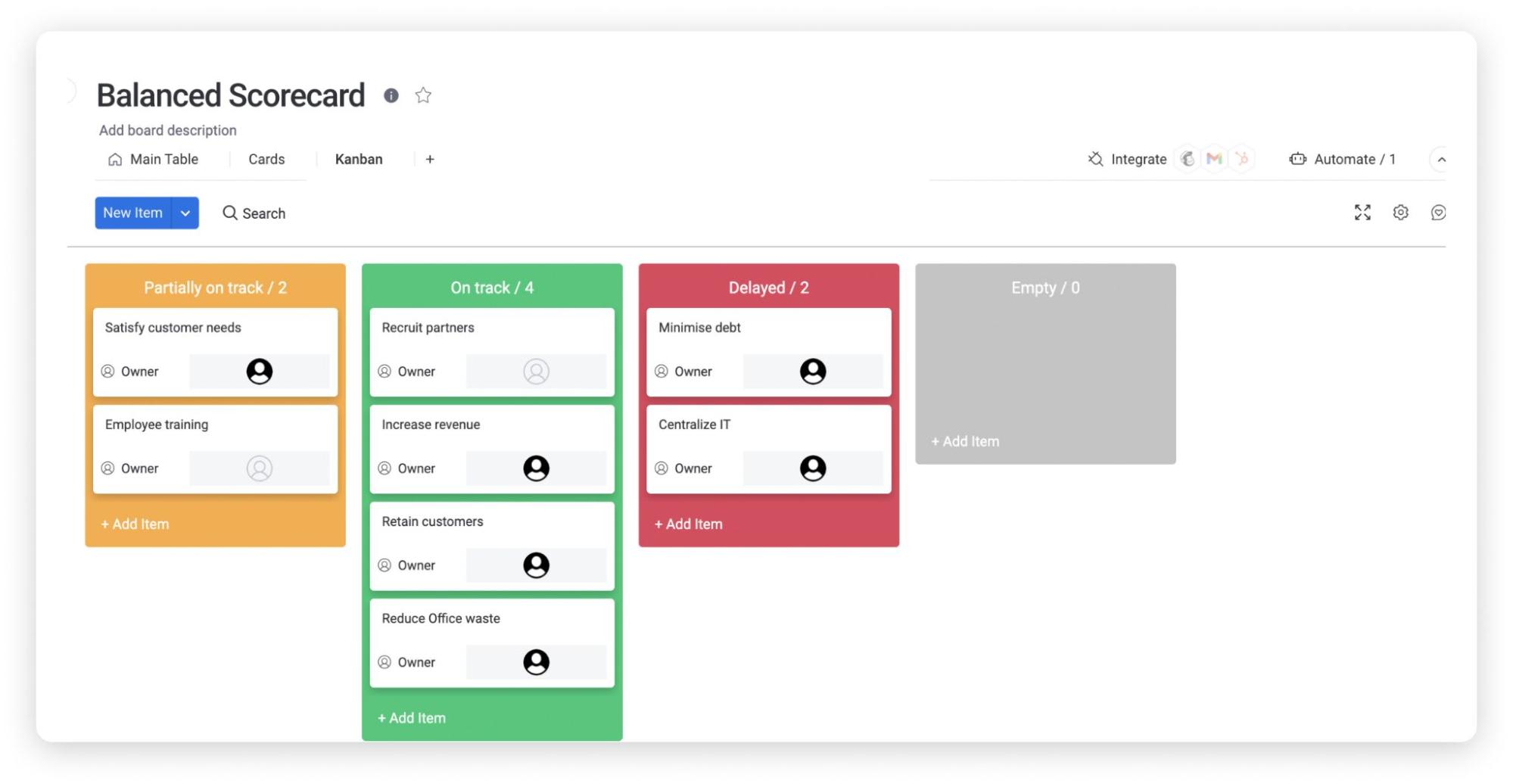Revenue leaders, customer service leaders, and operations leaders each have different goals, strategic initiatives, and measurements of success. Senior executives need to have an understanding of all facets, but perhaps not to the same depth.
That’s where the balanced scorecard template comes into play. A balanced scorecard template allows leaders to pull all of this data together into a high-level management report that shows the overall state of health of a company and any initiatives in play that influence growth, internal business process development, customer sentiment, and financial success.
In this article, you’ll learn exactly how using a template to build your balanced scorecard can save a ton of time and make your report more professional and presentable in the process. Plus, we’ll share with you a free template built on monday.com Work OS.
What is a balanced scorecard template?
The balanced scorecard framework is an organizational system for strategic planning and management that provides senior leaders with an overview of day-to-day business operations, initiatives, and activities from four key perspectives:
- Customer perspective
- Financial perspective
- Internal business perspective
- Learning and growth perspectives
A balanced scorecard template is a customizable document that, at a minimum, includes headers for each of these four perspectives, as well as fields below each for leaders to fill in the relevant information — such as changes in business processes and monthly results against key performance measures.
More complex balanced scorecard templates also include predefined sections for managers to include information such as:
- The company’s overall strategy
- Specific measurements, targets, and KPIs — key performance indicators
- Strategic goals and objectives for each perspective
Here’s what a typical balanced scorecard — BSC — looks like:

Why use a balanced scorecard template?
The primary reason leaders use balanced scorecard templates is that they make the process of organizing business operations a lot smoother, faster, and easier. Rather than having to start from a blank document every time they want to create a new BSC — not to mention figuring out how to structure it — managers can simply pull up the template, save a copy, and get to work plugging in important figures and process changes.
And, of course, the whole idea of this management tool is to give senior executives a high-level summary of the company at a glance, so it makes sense that we’d want to make the BSC creation process easy as well, right?
But a boost in efficiency isn’t the only reason balanced scorecard templates are so popular. Another major benefit delivered by these helpful documents is their ability to provide consistency and uniformity across multiple iterations.
The balanced scorecard model isn’t designed to be a single-use item. Ideally, you’ll be recreating or updating your BSC every quarter and comparing previous results against current organizational performance to analyze any progress you’ve made in your strategic plan. Templates make this comparison process a whole lot smoother, as each quarter’s BSC is organized using the exact same format, making them easier to read, comprehend, and interpret.
And finally, let’s admit it, not all of us have award-winning design skills, so it’s nice to have a beautifully and professionally designed document to present to our management team.
What are some examples of balanced scorecard templates?
Are you looking for a bit of inspiration to create your own balanced scorecard template? Check out these informative examples.
Simple balanced scorecard template
Balanced scorecards don’t have to be incredibly complex documents. Larger organizations might require more detail — and of course, it depends quite a bit on the preferences of the executives for whom you’re preparing the BSC — but small businesses and startups can generally get away with something relatively simple.
This balanced scorecard template is presented as a simple pie chart, with each quarter of the pie representing one of the four perspectives of the balanced scorecard model. Next to each perspective, you’ll notice fields to include metrics and information relevant to that specific business area. For example, the financial metrics this business is tracking are:
- ROI
- Cash flow
- Financial results — such as revenue and profit for the quarter

Detailed balanced scorecard template
This is an example of a balanced scorecard that dives into a whole lot more detail. It’s still fairly high level — compared to, say, a full-scale business report — but it follows a really helpful model of listing KPIs for each perspective, detailing the targets set out in order to improve on the KPIs, and then discussing the projects in play that are expected to influence performance against those targets.
Notice on the left-hand side of this balanced scorecard that there is a flowchart diagram that demonstrates the different strategic objectives this business has, with arrows between each to illustrate how the initiatives influence each other.

Government balanced scorecard template
Balanced scorecard templates can also be used to improve performance in the public sector, such as in this example of a local government BSC. At the top of the scorecard, you’ll see the government’s strategic themes and the results they measure in order to influence those themes. Below that, we break out into further detail, with numeric measures and targets in place, as well as descriptions of key initiatives.

monday.com’s balanced scorecard template
Are you looking to skip the whole template search and creation process and get right to building your first BSC? Then check out monday.com’s balanced scorecard software.
Our template makes designing a BSC simple, and because it’s built on monday.com Work OS, you’ll be able to:
- Pull financial data from your reporting dashboards
- Collaborate with remote users and assign ownership of tasks to update the BSC
- Customize the template to suit your organizational needs
- Create automated reminders to measure progress
- Add beautiful reports and graphs as appendices
- Include links to workdocs that describe new initiatives and process changes in greater detail
- See an overview of tasks and goals with the Cards view and track progress with the Kanban view

It’s worth noting that monday.com is more than just a place for creating reports like BSCs — it’s a place to get work done and design dream workflows. Our intuitive and collaborative Work OS makes light work of repetitive manual tasks through customizable automation recipes. With browser, desktop, and mobile app options, it’s the perfect companion for modern, distributed teams.

Balanced scorecard template tips & tricks
To help you get the most out of your balanced scorecard template, here are some tips to keep in mind:
1. Make sure each perspective is relevant to the overall company vision
The purpose of the balanced scorecard is to provide feedback on internal processes, strategic plans, and initiatives to improve business performance and achieve the goals of the company. When bringing information together to report in the BSC, ask how this information relates to the business’s strategic objectives.
2. Use actionable KPIs to track progress
Balanced scorecards should be reviewed regularly, and you need a clear way to determine progress each month or quarter and define when you have and haven’t made improvements.The best way to do this is to create actionable, measurable performance indicators — numeric KPIs work best as they are often the easiest to quantify — that each team or department has a direct influence on.
3. Establish a cadence for regular review
Depending on the size of your company, a quarterly review cadence may be appropriate. However, more agile startups might wish to step this up to monthly. In any case, agree upon a regular interval for reviewing the balanced scorecard and put some dates on the calendar.
4. Acknowledge the links between each perspective
While the balanced scorecard segments information into one of four perspectives, it’s true that there are often connections between each perspective, which you should illustrate in your BSC using arrows or dotted lines.
For example, supply chain improvements as part of the internal business perspective can also have an impact on operating costs, which would be reflected in the financial perspective.
FAQs about balanced scorecard templates
How do you create a balanced scorecard template?
Follow these steps to create a balanced scorecard:
- Goals: Determine your company’s key strategic objectives.
- Strategy map: Create a strategy map that illustrates the connections between the strategic goals you’ve just identified.
- Measurements: Decide on the metrics and measurements you’ll use to define progress toward your goals.
- Template: Download your balanced scorecard template, and fill it up with the relevant data.
How do you write a good balanced scorecard?
To write a great balanced scorecard, include the following:
- Clearly defined strategic objectives
- Measurable, specific, and actionable performance indicators
- Illustrated links between objectives and initiatives at each perspective
monday.com’s customizable balanced scorecard template can help you accomplish this. The ability to pull data from your reporting dashboards and use automated reminders allows your balanced scorecard template to stay updated and focused on your goals.
What are the four elements of the balanced scorecard?
The balanced scorecard includes objectives, processes, and initiatives from four perspectives:
- Learning and growth perspective
- Customer perspective
- Financial perspective
- Business process perspective
